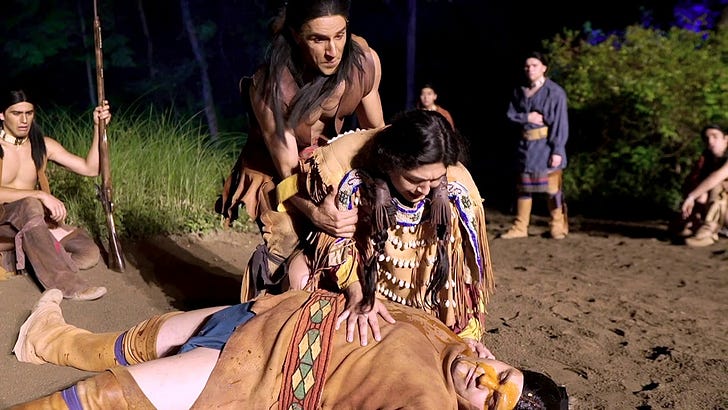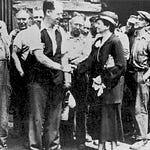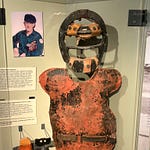I took a month-long motorcycle trip from North Carolina to Arizona and back during April, including a ten-day sojourn with family who’ve relocated there. During our visit we visited a restored archeological site in the Sonoran Desert. Today it’s known as Besh Ba Gowah, a term roughly translated from the Apache meaning “place of metal.”
Here’s a video overview of the Salado people who lived there between 1250 and 1450 CE.
Besh Ba Gowah made me realize how little I knew about native people in the Ohio River Valley, and that’s what inspired this month’s trivia quiz.
Did it ever occur to you that there are no Indian reservations in the Ohio River border states? Why is that?
Today, the absence of federally recognized reservations in the Ohio River border states is largely due to three factors: 1) historical displacement, 2) lack of territorial continuity leading to assimilation, and 3) the erosion of Native sovereignty through federal policies that led to economic control of these peoples by the U.S. government.
While some tribes in the region, like the Shawnee and Miami, have regained federal recognition in recent decades, they do not have large, contiguous reservations like those in the western U.S.
You might first think this happened as a result of the Indian Removal Act of 1830, which initiated a mass exodus of Native Americans, particularly from the southeastern U.S., to what is now Oklahoma, known as the Trail of Tears. While many tribes in the Ohio River border states were forcibly removed, some, like the Shawnee and Miami, were fragmented and dispersed across various regions. Those who remained were often not granted land rights or reservations.
However, the effort to erase Indian peoples and culture began much earlier than that Act. Land treaties and military conflict forced tribes in the Ohio Valley to cede large portions of their land. The Treaty of Greenville (1795), which followed the defeat of Native forces in the Battle of Fallen Timbers (1794), is a notable example of such a land cession. Tribes were often coerced or manipulated into giving up their territories in exchange for meager concessions, setting the stage for further removal.
In the late 19th and early 20th centuries, the U.S. government adopted policies of assimilation aimed at integrating Native Americans into mainstream American society. The Dawes Act of 1887, which sought to break up tribal lands into individual allotments, further weakened Native communities and prevented the establishment of reservations.
As a result of these policies, Native American populations in the Ohio River border states were marginalized, and many tribes lost federal recognition, making it difficult for them to claim land for reservations. Tribal members were often forced into state-controlled systems, which did not allow for the formation of reservations.
This website by the Chickasaw Nation is a treasure trove of video interviews and other resources.
Now on to the quiz!
Note to my fantastic new subscribers:
Monthly trivia is for sport. It’s not a test of intelligence or character. I couldn’t answer these questions without a significant amount of research, either! Do your best and enjoy learning something new.
QUESTIONS
Answers in the footnotes. Have fun!
What was the primary effect of the 1763 Treaty of Paris, following the end of the French and Indian War, on Native American tribes living in the Ohio River Valley?1
It granted Native Americans sovereignty over their lands
It established new boundaries that restricted Native Americans to specific territories
It allowed Native Americans to trade freely with European settlers
It recognized Native American alliances with the French
The Treaty of Greenville (1795) was significant because it marked a major land cession by Native tribes in the Ohio River Valley. What did the U.S. government promise in exchange? More than one may apply.2
Monetary compensation and trade goods for the land
A formal apology for the destruction of Native villages
Military support in protecting Native lands from further encroachment
The return of some land taken by settlers
Which Native American leader, who fought to protect his people’s land from European encroachment in the Ohio River Valley, became well-known after his leadership during the Battle of Tippecanoe in 1811?3
Tecumseh
Pontiac
Blue Jacket
Standing Bear
What were the main reasons for passing the Indian Removal Act of 1830? More than one applies.4
To relocate Native American tribes to reservations in the western territories
To provide land for European settlers to expand westward
To grant Native American tribes sovereignty over their lands
To forcibly assimilate Native Americans into European-American agricultural practices
The U.S. government created reservations for Native American tribes in the 19th century. Legislators didn’t come up with this concept on their own. What practices elsewhere inspired this policy? Yes, this is an essay question.5
Why were Native American tribes in the Ohio River border states (like the Shawnee and Miami) particularly vulnerable to displacement during the early 19th century? More than one may apply.6
They had no alliances with other tribes
Their lands were in the path of settlers moving westward
They lacked military power to resist U.S. forces
They had assimilated into European farming practices
Which of the following Native American tribes played a role in the resistance against European settlers in the Ohio River Valley during the 18th century? (Select all that apply)7
Shawnee
Miami
Iroquois
Cherokee
Which factor made the Dawes Act of 1887 particularly damaging to Native tribes in the Ohio River border states?8
It forced Native Americans to abandon their communal way of life and adopt European-style farming practices.
It granted Native American tribes full autonomy over their lands, allowing them to govern themselves.
It divided tribal lands into individual allotments, causing a loss of collective control and leading to the sale of surplus lands to non-Native settlers.
It created permanent reservations for Native tribes, offering them protection from further displacement by European settlers.
I can’t resist another Tecumseh question. The War of 1812 was a conflict between the United States and Great Britain, driven by issues such as trade restrictions, impressment of American sailors, and British support of Native American resistance to U.S. expansion. Which of the following statements about Tecumseh and his role in the War of 1812 are correct? Select all that apply.9
Tecumseh fought alongside British forces against the United States during the War of 1812
Tecumseh’s primary goal was to defeat the British and secure Native American sovereignty
Tecumseh led the Shawnee and other Native American tribes in an alliance with the British to resist U.S. expansion
Tecumseh was killed in the Battle of New Orleans, where he fought for the American cause.
Which of the following Native American tribes originally from the Ohio River Border States have gained federal recognition in recent years? More than one may apply.10
Shawnee Tribe
Miami Tribe of Oklahoma
Delaware Tribe of Indians
Pequot Tribe
ANSWERS
The only answer is b, and we’ve talked about this before here at the 981 Project. Pittsburghers have the best understanding of this since that’s the headwaters of the Ohio River. Some Native leaders hoped that the British would protect their lands and prevent American settlers from encroaching. However, the treaty did not acknowledge Native sovereignty or their rights to the land, and instead, it essentially opened up the western territories to American settlement. The result was increased pressure on Native lands, leading to further displacement, conflicts, and loss of territory.
So, while many Native groups might have believed the treaty would protect their land, it ended up having the opposite effect.
The answer is a: monetary compensation and trade goods for the land. It’s no surprise that settlers continued to encroach on Native lands after the treaty was signed, which led to further conflicts.
The correct answer a) is also familiar to faithful readers: Tecumseh. However, Blue Jacket in answer b) and Tecumseh were contemporaries and both were from the Shawnee tribe. Blue Jacket fought alongside Tecumseh and was part of the broader resistance to American expansion during Tecumseh's efforts to create a confederation of Native American tribes. If you want to give yourself credit for Blue Jacket, be my guest.
Pontiac’s rebellion occurred earlier, and Tecumseh's rise as a leader came after the defeat of Pontiac’s efforts.
Standing Bear was a Ponca chief best known for his legal battle in the 1870s, when he became the first Native American to be recognized as a person under U.S. law in a landmark court case.
The Indian Removal Act was primarily aimed at making room for European settlers by relocating Native Americans to lands west of the Mississippi River. The U.S. government wanted to open up lands in the Southeast for farming and settlement, especially in areas like Georgia, Alabama, and Mississippi. This means the correct answers are a) and b).
Although c) to grant Native American tribes sovereignty and d) to forcibly assimilate Native Americans were goals in the broader context of U.S. policy, they were not the main driving forces for the passage of this specific Act. The Act was more about clearing lands for settler expansion rather than empowering Native American governance or pushing them toward assimilation, although assimilation did occur as part of U.S. policy during this era.
The idea of creating reservations for Native Americans was not original to the U.S. government; it was influenced by colonial precedents in other parts of the world where powers like Britain, Spain, and France used land designations as a means of controlling indigenous populations.
Take the case of Great Britain in Canada, where Native American peoples were confined to reserves after treaties were made with colonial governments. These reserves were often quite small and limited the movement of indigenous peoples. The Indian Act of 1876 in Canada, which formalized this system, is a direct precursor to the idea of Native American reservations.
U.S. reservations became an instrument of displacement, assimilation, and economic control, all under the guise of protecting Native American tribes from encroachment while clearing land for settlers.
The correct answers are b) and d).
b. Their lands were in the path of settlers moving westward: This was a primary reason for displacement. As settlers expanded westward, they encroached on Native lands, particularly in the Ohio River Valley, making it a region ripe for conflict and eventual forced removal.
d. They had assimilated into European farming practices instead of retaining their traditional communal, often nomadic, ways of life. By adopting European-style farming—which emphasized private land ownership, the nuclear family structure, and intensive agriculture—Native communities were encouraged (or forced) to abandon their collective land use, tribal governance, and cultural practices. This shift weakened tribal cohesion and made it easier for the U.S. government to impose policies that undermined Native sovereignty. The U.S. policy of promoting European-style farming as a form of "civilization" was, in many ways, a double-edged sword. It encouraged Native Americans to adopt practices that made them more vulnerable to U.S. policies like removal and displacement under the guise of progress.
While tribes like the Shawnee and Miami did not have a united front with all tribes, they did form alliances (e.g., Shawnee's leadership under Tecumseh) during resistance efforts, though they were not as cohesive or strong as later confederacies. While it's true that these tribes were at a military disadvantage, this is more a consequence of their vulnerability, not a root cause of it. It’s the geopolitical situation (land being in the path of settlers) and assimilation into European systems that made them more susceptible to the removal policies.
The correct answers are a), b), and c). The Shawnee and Miami were key players in resisting European encroachment in the Ohio River Valley, often aligning with either the British or the French, depending on the period. The Iroquois Confederacy, though located farther east, was influential in the region and was involved in various conflicts during this time, particularly through their alliances.
The Cherokee (answer d), while involved in other parts of the American Southeast, were not as central to resistance in the Ohio River Valley during the 18th century.
Answers a). and ). are correct. The Dawes Act sought to break up tribal land holdings by allocating parcels to individual Native Americans, often far smaller than the communal lands they had traditionally occupied. This approach undermined tribal sovereignty and traditional systems of land use, as well as diminishing the land base of Native nations. This policy aimed to change Native cultures by forcing them into a foreign agricultural system and individualistic ownership model.
The Dawes Act did not create reservations. Reservations were already established earlier in the 19th century as a way to remove Native Americans from lands that were opened up for European settlers. The Dawes Act sought to break up these reservations into individual allotments, undermining the idea of reservations as collective spaces for Native communities.
First off, “impressment” was the practice of forcibly recruiting sailors into military service, particularly by the British Navy during the 18th and early 19th centuries. British naval ships would stop American merchant vessels and seize sailors, claiming they were deserters from British ships, or sometimes forcibly taking Americans who were not even British citizens. This practice was one of the major grievances that led to the War of 1812 between the United States and Great Britain, as it violated American sovereignty and rights on the high seas.
The correct answers to this question are a) and c) Tecumseh led the Shawnee and other Native American tribes in an alliance with the British against the United States during the War of 1812 to resist U.S. expansion.
Tecumseh believed that a strong Native confederacy, supported by the British, was the best way to secure Native sovereignty. He was not killed at the Battle of New Orleans; he was killed earlier, during the Battle of the Thames in 1813, while fighting alongside British forces.
The correct answers are a) and b), but c) was sneaky in its error.
The Shawnee Tribe, originally from the Ohio River Valley, has gained federal recognition in the 20th century, though much of their population is now located in Oklahoma.
The Miami Tribe, also originally from the Ohio River Valley, was recognized by the U.S. government in the 20th century, and today, most members of the Miami Tribe reside in Oklahoma, following their forced relocation during the 19th century.
While the Delaware did have a significant presence in the Ohio River Valley, their federal recognition was not recently gained, as they were recognized much earlier, and their history spans several states and relocations, including significant portions in Oklahoma.
The Pequot are primarily from Connecticut and are not connected to the Ohio River border states. They gained federal recognition in 1983, but this tribe has a very different history and is geographically unrelated to the Ohio River region.












